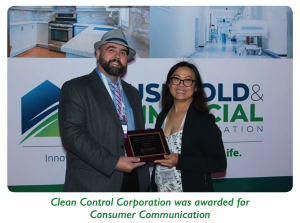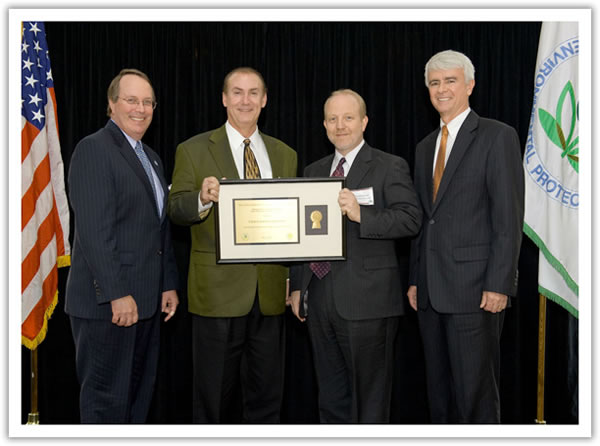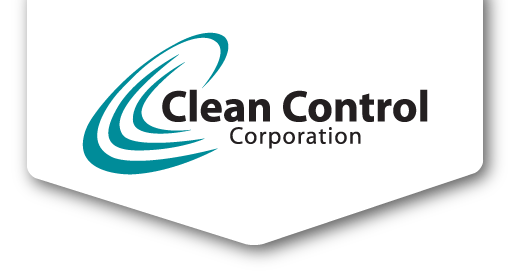
Awards & Achievements
Background
Since 1991, Clean Control Corporation has made an effort to produce effective products using the safest chemicals possible while complying with environmental, safety and health regulations.
December 8, 2019

David Sexton, CCC Technical Director, accepts HCPA Innovation Award on behalf of Clean Control Corporation for the OdoShow.
The OdoShow (Launched April 2019) is a new social media effort to better connect with and inform customers. In order to leverage the current popularity of live streaming video across multiple distribution channels based around a live broadcast show.
The show can be seen live on Facebook, Instagram, and YouTube simultaneously, allowing customers and fans to directly interact with employees of the company and cleaning experts. Live interaction made possible through use of the commenting structures available on the social media platforms. The live show content used to create additional touchpoint content in the form of an audio podcast and multiple pre-produced infotainment videos.
All of the content is available through a wide range of online platforms, including Facebook, Instagram, YouTube, the Google Play Store, iTunes, and Stitcher. The live shows may be viewed on the brand’s Facebook page: https://www.facebook.com/odobanproducts.
The archived shows and supportive content may also be viewed on the brand’s YouTube channel: https://www.youtube.com/user/Odobanproducts/playlists
May 15, 2017
Clean Control Corporation receives 2017 Partner of the Year Award.

Pictured Left to Right: Wendy Cleland-Hamnett, Acting Assistant Administrator of EPA’s Office of Chemical Safety and Pollution Prevention (OCSPP); Stephen Davison, President/CEO, Clean Control Corporation; David Widawsky, Director, Chemistry, Economics and Sustainable Strategies Division (OPPT, OCSPP).

Pictured Left to Right: Cory Hammock, Vice President of Research & Development, Clean Control Corporation; Stephen Davison, President/CEO, Clean Control Corporation, Brianne DiLorenzo, Business Analyst, Clean Control Corporation; David Sexton, Technical Director R&D, Clean Control Corporation.

Pictured Left to Right: Eden Davison, Stephen Davison, President/CEO, Clean Control Corporation; David DiFiore, Safer Choice Program, U.S. EPA.
May 5, 2017
May 9, 2016

Pictured Left to Right: Jim Jones, Assistant Administrator (OCSPP); Barbara Cunningham, Deputy Director for Management and Pollution Prevention (OPPT, OCSPP); Wendy Cleland-Hamnett, Deputy Assistant Administrator (OPPT, OCSPP); Cory Hammock, Vice President of Research & Development, Clean Control Corporation; David Sexton, Technical Director R&D, Clean Control Corporation; Stephen Davison, President/CEO, Clean Control Corporation; David Widawsky, Director, Chemistry, Economics and Sustainable Strategies Division (OPPT, OCSPP), Brianne DiLorenzo, Business Analyst, Clean Control Corporation, Louise P. Wise, Deputy Assistant Administrator, (OCSPP).
April 28, 2016
December 2014
November 2013
January 2013
April 2012
March 2012
January 2011
June 17, 2009
November 2008

March 24, 2008
October 2006
June 12, 2006
December 2005
The USEPA issued Ambient Aquatic Life Water Quality Criteria – Nonylphenol (EPA-822-R-05-005). This document was a guideline for Agency decisions made by applying the Clean Water Act and EPA regulations on the basis of specific facts presented and scientific information then available.


